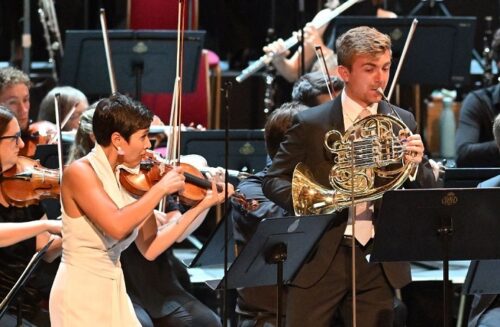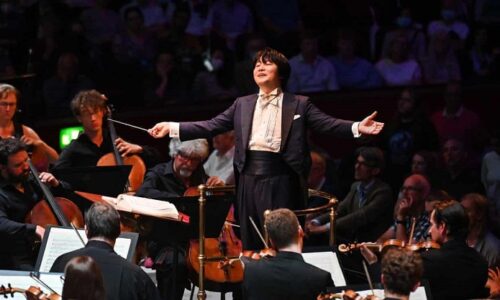
 United Kingdom BBC Proms 2022 [8], Prom 14 – Glinka, Smyth, Rachmaninoff: Elena Urioste (violin), Ben Goldscheider (horn), City of Birmingham Symphony Orchestra / Kazuki Yamada (conductor), Royal Albert Hall, London, 25.7.2022. (MBr)
United Kingdom BBC Proms 2022 [8], Prom 14 – Glinka, Smyth, Rachmaninoff: Elena Urioste (violin), Ben Goldscheider (horn), City of Birmingham Symphony Orchestra / Kazuki Yamada (conductor), Royal Albert Hall, London, 25.7.2022. (MBr)

Glinka – Ruslan and Lyudmila – overture
Ethel Smyth – Violin Concerto for Violin and Horn
Rachmaninoff – Symphony No.2 in E minor
Although there are clear exceptions – Seiji Ozawa and Tadaaki Otaka being the most notable – Japanese conductors are amongst the most insular when it comes to international careers. Takashi Asahina did work extensively in Germany in the 1960s, Hiroshi Wakasugi had a significant relationship with the Dresden Staatskapelle, Kazuyoshi Akiyama has had a flourishing career in Canada and the United States and Ken-Ichiro Kobayashi has had a long association, stretching back decades, with the Czech Philharmonic and orchestras in Hungary – but predominantly their careers have been, or were, based in Japan.
It is difficult to pinpoint reasons why this should be the case, other than, with the exception of Wakasugi, the relative conservatism and small size of the canon of works they conducted – not that this hindered either Giulini or Carlos Kleiber. Today’s Japanese conductors, from a generation beyond Expo ‘70, are entirely different, however; apart from the supremely gifted Tatsuya Shimono, there is Kazuki Yamada recently appointed the new conductor and artistic director of the CBSO from 2023.
I have known his work on disc for many years, going back to some of his first recordings made for Tomatone when he was conducting the Yokahama Sinfonietta. Some features of those early recordings are still evident in his concerts today – such as the lack of repeats in his performances. In his Schubert ‘Great’ from 2010, he avoids exposition repeats – and that is also the case with his Sendai Philharmonic Orchestra recording of Rachmaninoff’s Second Symphony from 2013. Getting on for a decade since that Rachmaninoff recording was made it is rather striking how similar this BBC Prom concert version with the City of Birmingham Symphony Orchestra was with that Japanese one. Tempos rarely deviated between the two, for example. In this sense he shares with Otaka – and Ozawa for that matter – an uncanny ability to keep his interpretations stable, although whether this is necessarily a positive thing is another question entirely. Asahina, on the other hand, conducted with such fluidity and spontaneity that none of his performances were ever the same – he may, in fact, be one of the most radical conductors of the twentieth century despite his deliberate conservatism. Perhaps a slightly better model than Ozawa, with whom Yamada studied.
Rachmaninoff’s Second plays to Yamada’s strengths in several ways. I have yet to come across any Japanese conductor who doesn’t really lack an innate feeling for Russian music – some of the best Tchaikovsky and Shostakovich you will find comes from the hands of Japanese conductors. Yamada, if not exactly a traditional Romantic, has the instincts of one. There was no lack of drama in this performance – he understands scale, how climaxes rise and fall – and nor was there any lack of colour either. Yamada shapes the contours of long movements in broad, sweeping arcs. One reason this performance never hung fire is simply because it never had time to fragment as so many performances of this work so often do.
In, of course, a correct performance of this symphony the Largo opens with the same instruments on which it will end – basses and cellos; there was no timpani ending to be had here. Yamada took a very incisive, even powerful view but this clarity at one end of the string spectrum was not something that always came across clearly elsewhere. The syncopated figure with divided violas didn’t come through and you barely got any hint of the Dies Irae in the violas either (more of that, as was so often the case in this performance, would come from the clarinets and woodwind where Yamada lavished extraordinary care). An unusual characteristic of Yamada’s approach, especially in the development section, was to give the symphony an almost ‘concerto’ feel to it. I have rarely been so drawn to the woodwind in this movement as I was here – the switch between the solo violin and clarinet, for example, even the interplay between woodwind and French horns felt less symphonic than they did as instrumental accompaniments within the symphony. Impressive, too, was a vivid sense of colour he wanted from individual players – the rugged, asperous horns or hovering floating flutes. Yamada got these effects with the most minimal of gestures – a characteristic of his conducting that gave us a symphony that was entirely moulded into shape rather than built up from its notes.
With no exposition repeat to the first movement and enough flexibility in his tempi the Largo never dragged – although neither did it quite somehow manage to have the sheer heft and darkness you want in this symphony. The CBSO strings have considerable beauty, but they lack weight where it matters – the bottom C on violas remained somewhat covered, and in the final movement the cellos at the beginning of the second theme didn’t really plunge as deeply as they might have. But there were compensations to be had, although one really had to look to the woodwind and brass to find them. In the second movement there were some magnificent silhouettes from the horns shadowing the woodwind, for example.
The Adagio, however, was very special. There are some orchestral solos – the flute solo in the final movement of Mahler’s Tenth is another – where from the very first note you can tell whether it is going to be exceptional or not. This was the case with the principal clarinet of the CBSO, Oliver James. His tone and phrasing were just extraordinarily beautiful; 22-bars of magical poetry. In part, a great deal of this must fall to Yamada who lavished such attention on James – and not so much as a conductor but as a collaborator as if the two were in conversation with each other. The first theme may be heard on the clarinet but it is like an accompanied cadenza and Yamada felt almost no need to focus on the orchestra instead placing implicit trust in their dynamics and phrasing. It would not be the first time he would do this during the Adagio. Often Yamada would just let the orchestra express itself, let each instrument follow the next as if this were chamber music. The string playing was ravishing – by any standards this was great playing and great conducting.
The finale could have fallen into something close to the trap of the opening Glinka work – galloping tempi with the conductor and orchestra having lost control of the reins – but it had considerable control in the end. There may just have been a touch more deliberate heaviness in the rubato than in Yamada’s recording on Exton – a willingness to round off the climaxes with wider edges rather than more circumspect ones, some pulling back of the in stringendo tempos. But there was no denying its excitement, the cleverness that Yamada brought to the cascading maelstrom that pulled the CBSO in and out of Rachmaninoff’s concluding vortex.

He had displayed similar skill with Ethel Smyth’s unusual Violin Concerto for Violin and Horn. Written in 1927, the work is uneven, almost running out of steam and imagination after the Finale’s cadenza. Written towards the very end of Smyth’s career I think the concerto, despite its technical difficulties, lacks the brilliance and stamina of her earlier works. Even though this particular performance of it was very well proportioned – with a well-balanced violin (Elena Urioste) and horn (Ben Goldscheider) – the playing sometimes felt inconsistent with what Smyth had written. Some of Goldscheider’s playing was more tonally rich than the music often deserved, especially in the Elegy. Urioste, not a violinist with the biggest tone, but certainly one with a rich one, gave a generous daubing of colour to the Elegy – but it didn’t seem comfortable with the music. The harp writing is unusual in that it is so prominent although one has to ask oneself why it is there at all. Whatever merits the concerto might have are cut short by the Finale – by far the weakest movement where after a cadenza, not unlike the vastly superior unaccompanied Elgar, the concerto seems to lapse into unconstrained playfulness. The performance was solid, but with five outings at the Proms have we heard enough of this concerto?
The opening work on the program, Glinka’s Overture to Ruslan and Lyudmila had certainly packed a punch. Taken at a very fast pace the strings – if never really in danger of falling out of sync with the rest of the orchestra – certainly felt as if they might be living on borrowed time. All the early indications of Yamada’s skill as a conductor came through in miniature here – the balletic body movement, the delicate and feather-light baton control, the carefully articulated left-hand that he used to get such expressive playing from the orchestra.
This had been the conductor’s Prom’s debut – a rather belated one, I think. For many it will have been an introduction to this exceptionally dynamic, and highly talented conductor; for others a confirmation that his partnership with the CBSO is a symbiotic one. Birmingham is indeed a lucky place.
Marc Bridle
